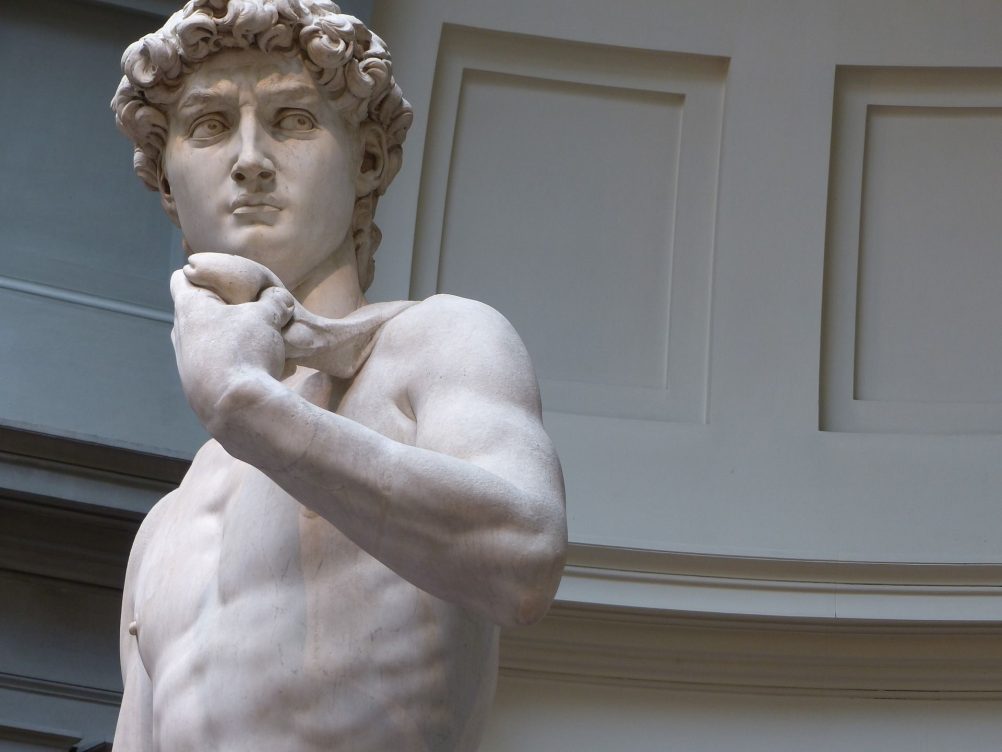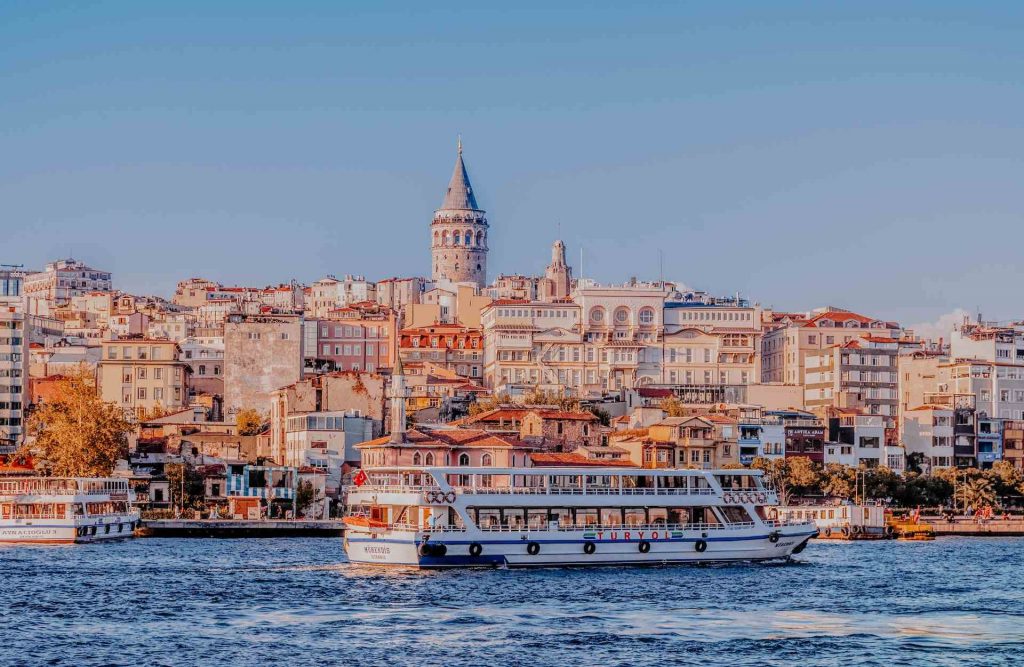Florence: stories carved into stone
From Michelangelo’s marbles to Brunelleschi’s “impossible” dome, Florence’s glory is captured in stone.
Words by Ute Junker
Photos by Christian Hardi from Pixabay
The statues in Florence do not stand still. Wherever you look, the stone figures seem to have been caught in the middle of frenetic activity: torsos twisting, muscles flexing. In the Bargello, the former dungeon that is now the national sculpture museum, a tipsy Bacchus is caught in a moment of unsteadiness, trying to arrest his sway. He seems positively restrained, however, when compared with the four unfinished slave statues over in the Accademia museum. Unlike the drunken god, who retains some composure, these are beings possessed, appearing to fight their way free of the rock in a struggle to be born.
Why are Florence’s statues so filled with vitality? The answer is simple: Michelangelo. Florence’s most famous son made an art of capturing struggle in stone. His figures – which include the Bacchus and the slave statues – are always twisting, tense if not tortured. Michelangelo changed the game. After they had seen his sculptures, no-one was interested in static statues – they expected figures full of life, and sculptors had to deliver.
You can see Michelangelo’s influence in the Loggia dei Lanzi, the city’s preeminent al fresco sculpture gallery. The sculptures on display, the work of later artists such as Giambologna, are full of Michelangelo-style movement. Hercules swings his arm back to deliver the death blow to a writhing centaur. Nearby, virile Romans strain their muscles lifting Sabine women, struggling desperately to free themselves.
Contorted bodies were just one of Michelangelo’s lasting legacies. The other was his choice of material. Michelangelo was mad about marble. Carrara marble, quarried not far from Florence and characterised by a creamy white or pale grey colour, was not just his favourite medium, it was virtually his only medium. His four monumental frescoes, two bronze statues, one wooden crucifix and a couple of paintings pale into insignificance when compared with the 300-plus marble sculptures he worked on throughout his career. Many of his signature works – such as the giant statue of David, also on display in the Accademia – were done in marble.
Michelangelo was many things: a sculptor, an architect, a poet, a painter, one of the great geniuses of the Renaissance. What he was above all else, however, was Florentine. More than most cities, Florence has an affinity for stone. Here, in the birthplace of the Renaissance, the city’s artists achieved their greatest triumphs working in stone.
Florence is the city where Filippo Brunelleschi astounded the world’s architects and engineers, constructing a dome for the city’s cathedral that was so mammoth, no-one believed it could be done. Brunelleschi’s invented new engineering techniques and used four million bricks in the dome, including triangular and other oddly-shaped bricks.
Similarly, Michelangelo’s magnificent sculpture of David was the first colossal statue carved from a single piece of marble since ancient times (his earlier Bacchus had been something of a test run). To make his task even more difficult, Michelangelo was given a shallow block of marble that had been badly roughed out by another sculptor. Michelangelo’s solution, typically, was to swivel David’s body, having the hero lean forward slightly to fit within the block.
Florence’s sculptors weren’t the only ones to appreciate the serene whiteness of Carrara marble. The stone also features in the facades of some of the city’s most beautiful buildings. The church of Santa Croce has an intricate pattern of white, pink and green marbles, a fresh-looking combination that was chosen because it represents the chief Christian virtues: white for purity, green for hop and red for love and charity.
The church of Santa Maria Novella, by contrast, has a striking façade of black and white marble which is unlike anything else in town. “This is the only Renaissance façade in Florence. It stands out for its geometry and mathematical proportion: beautiful, measurable, symmetrical,” says Valerie Niemeyer.
Niemeyer leads the Colours of Florence walk for Context Tours, which examines the history of Florence through its building materials. The revealing tour shows that you don’t need to step into a museum to learn about history: if you know where to look, it’s all around you.
Take, as an example, the city’s spacious piazzas. Never merely decorative, the purpose of each square depends on its placement. The piazzas outside the grand churches of Santa Maria Novella and Santa Croce were designed as gathering places, where large crowds could assemble to hear the word of God.
The piazzas created by the civic authorities, on the other hand, had a very different purpose. The Piazza della Signoria outside the Palazza Vecchio, for instance, was deliberately created through a clearance program. Rather than saving souls, the city fathers were concerned about saving the government. In the event of public insurrection, the administration wanted to make sure that the seat of government, the Palazzo Vecchio, could be easily defended.
Even the materials used in the buildings have stories behind them. The Florentines sensibly used the stones they had to hand. The city surrounds were dotted with quarries – even the Boboli Gardens behind the Pitti Palace was once a quarry. The most common stone in the area, and therefore the most common building material, is the honey-coloured sandstone called pietraforte. It was used to construct many of the city’s most famous buildings, from the Palazzo Vecchio to the Duomo, and even the city walls.
The sandstone is often relieved with feature stones such as serpentine, a pale green stone from Prato; red marble called portasanta; and pietra serena, a grey stone that is often used decoratively to relieve severe facades. “The architect Brunelleschi was among the first to use this stone as an architectural feature,” Niemeyer explains.
The elegant proportions that characterise so much Florentine architecture are a reminder that for many centuries, the city’s most powerful bodies were its artist guilds, including sculptors, builders, textile workers and masons. They generated the wealth that gave the city its power, and they patronised the sculptors and architects who enriched the city with their work. No wonder that so many of the projects they commissioned stand as true works of art.
Like any city, Florence has changed its face several times over the centuries. Traditionally a city which hid its wealth behind simple, unadorned walls, under the Medici Florence gradually began to develop a love of display. The elegant exteriors that decorate churches such as Santa Maria Novella and Santa Croce today are part of a program that saw plain exteriors updated with more ostentatious designs.
The best illustration of what Florence once looked like can be found at the Basilica of San Lorenzo, one of the city’s oldest and most important churches. The city’s original cathedral had its function usurped by today’s Duomo, but remained the family church of the powerful Medici family.
Seen from the outside, there’s little to suggest its importance. Its dimensions are clearly spacious, but the rough-hewn surface, with its crumbling bricks, is reminiscent of an overgrown barn. Michelangelo designed a marble façade to replace the rough exterior, but never got around to delivering the project. The detailed plans still exist, and occasionally Michelangelo fans try to revive them. However, it seems the Florentines have retained a fondness for a bit of rough – so far, at least, the worn façade has survived.
Perhaps they learnt their lesson from the Medici’s hubristic Chapel of the Princes. This grandiose project was the last fling of the family that shaped much of the city – and it broke with tradition in many ways.
It is not a structure that could be described as understated. Even the most enthusiastic guidebooks display a certain contempt for the building, variously calling it “a monstrosity” and “an exercise in bad taste”. The interior of the octagonal chapel is Baroque bling, every surface covered in semi-precious stones and multi-coloured marble, a visual overload that makes your eyeballs ache.
Its gaudy stonework contrasts with the clean lines that dominate of the rest of the city. The ambitious design not only exceeded the boundaries of taste, it also helped sink the Medici family fortunes. The rare stones, which had to be shipped in from far distant lands, were ruinously expensive. Money ran out more than once, and the entire design took several centuries to complete – thus proving that the Florentines had been right all along in choosing to keep it local.



